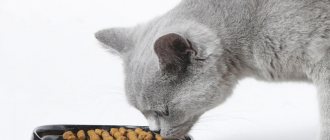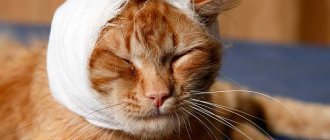All owners who decide to get a tiny mustache are advised to familiarize themselves in advance with how to care for a kitten. In the first months of life, he strongly resembles an ordinary child. A furry baby requires a lot of attention and care, so experienced breeders recommend taking a short vacation while it adapts.
At what age is a kitten taken to a new home?
Caring for a one-month-old kitten is the most problematic. Don’t rush to take home the little lump you like immediately after meeting him. There is a chance that he needs a little more time to gain strength before moving to a new home.
Perfect time
The optimal age for separation from a mother cat is 2.5-3 months. From this moment on, her cubs switch to a normal diet, so the stress from the sudden loss of a beloved breast will be minimal.
It is also important for the future owner that the appearance of a three-month-old cat is unlikely to change. Small variations are only acceptable among a limited range of breeds, including the Siamese. These snow-white beauties will gradually darken for almost a year, so be sure to capture such a unique moment with a series of photographs.
Help getting used to a new home
Unlike adults, small pets quickly adapt to a new place and get used to their owners. But don’t be surprised that in the first days the baby will miss his mother a lot. Puzzled by her search, he can turn the entire apartment upside down, so remove all dangerous objects from his path in advance.
For easier adaptation, it is recommended to take something from a nursery or shelter that is saturated with a familiar smell. Its aroma can calm the cat in moments of sadness.
Getting to know new family members should happen gradually. If there are other cats in the house, be sure to make friends with them to avoid conflicts in the future. Let your pets get used to each other's scent from a distance and only then bring them nose to nose.
Newborns: up to 7 days
Kittens are born deaf, blind and very small. Signs that a kitten was born recently:
- the umbilical cord on the tummy has not yet fallen off (the tail dries out by 3-4 days);
- the ears are pressed tightly to the head and seem to be overgrown (open on days 5-7);
- eyes closed;
- there are no teeth in the mouth at all;
- weight 90-120 g, tiny sizes.
It is difficult to feed such babies without a mother; it will require enormous effort. A heating pad (heat source) and cat milk replacer are needed, which is given every 2 hours.
What should you buy for your baby first?
Before the arrival of a new family member, you need to arrange a personal corner for him and take care of buying basic things. Thanks to the inviting environment, your mustache will get used to the change of residence much faster.
Tray, filler and scoop
To relieve yourself, you will need a closed or open tray. The first type perfectly masks odors, but due to its impressive size it often crowds the human toilet. The second type often confuses people with dirt. Because of this, experienced owners recommend taking a model with a mesh and placing the filler not on top, but directly under it.
The filler itself is:
- woody;
- grain or paper;
- silica gel;
- clay or mineral.
Each type has its pros and cons, so study them carefully before purchasing. You will need a scoop to pour the filler. It can be purchased at any pet store or replaced with a children's spatula.
Carrying
This accessory will be needed not only for traveling to the country, but also for going to the veterinary clinic. If you are planning a long trip on a train or plane, choose a hard plastic model. In other cases, you can get by with a soft fabric carrier.
Please note that interactions with doctors rarely leave pleasant memories. If you take out the carrier only for this purpose, your pet will begin to hide from it under the sofa. For this reason, it is better to store it in a visible place so that the cat gets used to its smell.
Bowls for food and water
The required number of bowls depends on the diet. At a minimum, you will need 2 pieces: for food and fresh water. Another one may come in handy when feeding wet canned food.
The most reliable materials are metal and ceramics. Cheap plastic products quickly absorb foreign odors, and dangerous bacteria settle in their cracks.
Bed
The baby will choose a sleeping place on his own, so do not rush to install a cat bed without his consent. An open lounger or a special house is suitable for sleeping and relaxing. The first option is ideal for an unobstructed view of the territory, and the second is indispensable for modest pets who love silence.
scratching post
Without this item, you can say goodbye to your favorite sofa and recently hung wallpaper. For an active mustache, a large play complex with several tiers is suitable, where he can sharpen his claws, have plenty of fun and even sleep. For calm animals, a simple scratching post will suffice.
Feed
It all depends on age. If your baby has already started teething, then choose the type of food that is comfortable for you: natural or dry. The quality of the finished granules must be no lower than premium, since consuming economy grains can result in serious health problems.
What else will a tailed newcomer need?
The remaining items are considered additional, as they can be purchased a little later. They include tools and care products, as well as a variety of toys. There is no point in delaying their purchase, since hygiene procedures should be taught from childhood.
Claw cutter
To shorten claws that are too long, you will need a nail clipper. It differs from nail scissors in having a special recess for the claw. With this tool you don’t have to worry about peeling the nail plate or accidentally getting injured.
Accessories for combing
Without proper care, long-haired breeds quickly turn into a giant ball of tangles. Due to matting, hairs become thinner, break and fall out.
Combs with natural bristles and wide teeth, made of metal, as well as a special mitten brush will help preserve the beauty of your fur coat. During the molting period, a furminator can be used to remove fallen hairs.
There is no need to skimp on combing accessories. Ordinary plastic strongly electrifies wool, worsening its appearance.
Oral hygiene products
You need to brush your teeth not only for yourself, but also for your pets. Cats, like us, are not immune to caries and other oral diseases.
To care for your teeth, you will need to purchase veterinary toothpaste and a brush. A very comfortable model that fits directly on your finger.
Toys
Games are loved not only by ordinary children, but also by little cats. With their help, they learn the basics of hunting and throw out the energy accumulated during the day. Such activity has a positive effect on health, so the furry couch potato should be involved in joint games even as an adult.
Balls, mice and interactive toys are suitable for independent games, and teaser fishing rods for joint games. But you can also save money by making your own toy from thread and candy wrapper.
Other skin care products
To prevent ear pathologies, you need to keep your ears clean. Cleansing lotions that are instilled directly into the ear canal and regular cotton pads soaked in water will help with this.
If your pet gets dirty during dusty renovations or crazy runs through the garden beds, then you will need cat shampoo to save it. An ordinary human one will not work - it can provoke an allergic reaction.
Another important tool is a special spray used for toilet training. Depending on the components, it can attract the animal to the tray or scare it away from relieving itself in the wrong place.
The most important point is feeding
Proper nutrition is the key to your pet's health. Pay special attention to this moment.
When feeding naturally you should avoid:
- river fish and bones;
- white cabbage and legumes;
- lard and pork;
- pearl barley, corn and millet;
- mushrooms and potatoes;
- sorrel, onion and garlic;
- raisins and grapes;
- any products from the human table.
With dry food everything is much simpler. Here it is important to focus on the standards specified by the manufacturer, not to buy low-quality brands and choose age-appropriate lines. Please note that you will have to adhere to the chosen type of nutrition throughout your life.
Feeding a newborn without a mother
Newborns are fed special formulas, the composition of which is close to cat milk. Cheaper options (goat's and cow's milk) are fraught with vitamin deficiency and intestinal disorders in babies.
Prepare for sleepless nights. For the first 2 weeks, the cat will have to be fed every 2-3 hours, that is, approximately 7-8 times a day. A night break (no more than 5 hours) can be introduced only in the 3rd week. It is better to check the daily dose with a veterinarian, since it is very easy to overload a child’s stomach.
Feeding at 1 month: introduction of complementary foods
At 3-4 weeks, the first milk teeth appear, so caring for a 1-month-old kitten differs from caring for a newborn. From this moment on, the first complementary foods can be introduced into the diet. All food served must be boiled and crushed to a puree-like consistency.
The baby is fed 6-7 times a day in small portions of 17 g. In addition to milk, the menu includes boiled yolks, minced meat, milk porridge from semolina and rice, low-fat fermented milk products and vegetable puree.
Feeding from 2 to 4 months
Caring for a kitten for 2 months is supplemented by the inclusion of solid food. Well-frozen and boiled meat and fish are cut into small pieces, replacing minced meat with them. The daily portion is increased to 150 g, and the number of feedings is reduced to 5.
From 3 months, when calculating portions, the weight of the animal is taken into account, as the body enters a phase of rapid growth. For every kg of weight there should be 200 g of food, and the frequency of feeding should be reduced to 4 times.
The amount of fermented milk products is reduced in favor of meat and raw vegetables. It is also recommended to give up milk and reduce the amount of water used when cooking porridge.
Feeding from 5 to 7 months
Puberty often occurs during this period. Pets of different sexes living under the same roof mature before anyone else.
The regime is gradually being brought closer to that of an adult, so that the eight-month-old cat no longer eats 4 times, but 2 or 3. The portion also increases, since the weight does not stand still. This indicator should be monitored very carefully, since undersupply and excess are equally harmful to health.
Feeding a grown pet
Older cats are fed twice a day, but the veterinarian may make some changes to this routine. Make sure your pet gets enough protein, fat and carbohydrates. The ideal percentage ratio of these elements is 52:36:12.
The majority of the diet should consist of proteins of meat origin, that is, meat, fish and offal. The menu also needs to include vitamins and minerals that cannot be replenished with regular food.
Vitamins and supplements for three-week-old kittens
As soon as a three-week-old kitten begins to navigate in space, you need to try introducing complementary foods. In parallel with the introduction of complementary foods, the diet is enriched with vitamins and supplements.
The most important role in the nutrition of 3 week old kittens is played by proteins (proteins) and amino acids. Taurine is one of the rarest, but urgently needed amino acids for the normal development of kittens. Natural sources of taurine are:
- Homemade live yogurt.
- Whole milk.
Pharmacy vitamins can be added to the first complementary foods:
- Fish fat.
- Omega-3, Omega-6.
- B vitamins.
Pet stores sell commercial vitamin complexes for kittens, but they are intended for animals older than 1–2 months. If there are no alternatives, vitamins for kittens are crushed, dissolved in water and dosed by weight.
Hygiene procedures
Knowing how to care for a kitten at home, you can easily avoid diseases that arise due to insufficient hygiene. The care products discussed earlier will help you with this.
Teeth cleaning
This procedure will not take much of your time, since on average a cat's teeth need to be brushed only once every 2-4 weeks. On other days, it is recommended to use chewing toys and special treats to prevent the formation of tartar.
Cleaning ears and eyes
The ears are cleaned every 2 weeks, and the eyes as they become dirty. For this it is better to use a cotton pad. Ordinary cotton wool can injure the mucous membrane with its villi, and a cotton swab can damage the eardrum. In addition to lotions and water, herbal infusions of chamomile or calendula are suitable for cleansing.
Nail trimming
Overgrown claws are trimmed without affecting the pink part of the plate. This is done as it grows, not forgetting to disinfect the nail clipper before each procedure.
Is it necessary to bathe your pet?
Before vaccinations, it is better not to wash the kitten, since due to temperature changes, the fragile body can catch a cold. In other cases, swimming is permissible, but only if it is heavily soiled.
Features of caring for some breeds of kittens
British, Scottish kittens
Caring for these cats differs from usual in several nuances. The ears require special attention, which should be clean and smelling good. Ear care involves removing tassels if any appear on the ears. And, of course, grooming. British and Scottish cats are the only short-haired kittens that enjoy being brushed against the grain. Caring for cats of these breeds includes two brushings per week, long and massaging.
Sphinxes
The skin, eyes and ears of sphinxes need your regular help - the basic rules for caring for kittens of these breeds. Sphynx cats sweat, so their skin needs to be wiped with a damp sponge regularly. Random hairs that appear on the skin must be mercilessly removed. In addition, it is important to provide Sphynx cats with the opportunity to sunbathe a little (we emphasize, a little).
Since kittens of this breed do not have eyelashes, their eyes are more likely to become dirty. Rubbing with tea leaves or special drops solves this problem.
And the large (let us add, also very hot) ears of sphinxes are just a box for the accumulation of brown discharge. We clean the Sphynx's ear when there is a hint of contamination!
Shorthair cats (Abyssinian, Thai, exotic, Siamese)
These breeds do not require complex care. Regular cleaning of ears, teeth and eyes, gentle combing and cleaning of the mouth - and the kitten is fine!
Long-haired cats (Persians, Maine Coon, Siberian cat)
How to care for a cat so that its fur is of high quality? You will have to run with a tambourine, that is, observe a certain complex ritual. Firstly, arm yourself with an arsenal of combs, and secondly, remember the instructions for caring for a long-haired pet:
- collect fallen hairs with a mitten brush;
- Use a sparse comb to comb the fur in the direction of growth;
- Use a frequent brush to go over problem areas (stomach, panties);
- powder the wool. Voila - the kitten can be sent to a beauty contest!
Taking care of your health
A homebody cat is not immune from infection by parasites and viruses. For this reason, it must be regularly treated against various pests and vaccinated.
Treatment for ectoparasites
Preparations for fleas, ticks and other ectoparasites are used during periods of increased activity, before mating and vaccination. The method and frequency of use depend on the type of product chosen.
Deworming
Treatment for worms is carried out every quarter or every six months. Deviation from the schedule is possible only with direct infection or vaccination, participation in exhibitions, travel abroad, as well as with surgical intervention.
When do you get vaccinated and get a veterinary passport?
The first vaccination is given at 2-2.5 months, that is, after separation from the mother. All data on the administered drug is included in the veterinary passport, so this document is created after the first application.
The decision on castration, sterilization and their timing
The ideal age for surgery is 7-8 months. It is recommended to sterilize the cat before the onset of her first heat, as this reduces the likelihood of developing cancer in the future to 0.5%.
Education methods
It’s better not to delay education. A mature animal will listen to you with much less enthusiasm than a foolish baby.
Tray training
On average, litter box training takes about 2-4 weeks. In addition to your persistence, you should pay attention to the accessibility of the tray and the privacy of the space allocated for it. A constantly open toilet door can negate all your efforts, since cats do not tolerate violations of their personal space during such intimate moments.
Training to a scratching post
Use liquid catnip and other products that attract cats' attention with their scent. Prevent damage to foreign objects so that the pet understands that everything except the scratching post is prohibited.
How can you punish a guilty animal?
As a punishment, use prohibition commands, pronounced in a strict and accusing intonation. Accompany them with a spray from a spray bottle or a newspaper clap on the floor near the offender.
Remember that assault and loud shouting are prohibited. Such parenting methods can lead to serious mental problems.
Is it possible to train a cat?
It all depends on the specific animal. Most cats can be taught the fetch command. They love to hunt and often bring balls and mice to their owner, getting involved in joint play.
How many months is a kitten considered to be?
Experts agree that a cat becomes an adult at the age of 1 year. As you approach this age, you will notice a change in many factors:
- teeth will be completely replaced;
- character will be fixed, like most habits;
- a developed hunting instinct, which he often uses;
- outwardly looks like an adult animal, movements are smooth, graceful;
- a period of puberty will pass (fickle mood, loss of appetite, cats marking their territory, and cats going through their first heat).
When does a kitten become an adult cat?
An adult cat is no less a responsibility for the owner. But congratulations, you have already passed the main stage! The cat's body is fully formed and the active growth phase is completed. Then there are questions about castration, suitable food, combing...











